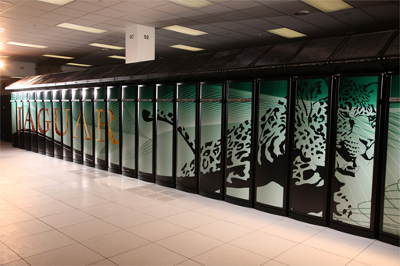Other Facilities
Oak Ridge National Laboratory
Many Center faculty at the University of Tennessee, Knoxville hold joint appointments at Oak Ridge National Laboratory, which allows them to make use of ORNL’s world-class facilities.
GridEye

Based on the success of the FNET project at Virginia Tech and the University of Tennessee, Knoxville, a full-scale monitoring infrastructure called GridEye is under development at ORNL. GridEye will provide an independent observation system of U.S. power grids, covering all three interconnections. The GridEye infrastructure will be an excellent platform for many real-time monitoring applications, as well as offline data mining and analysis functions.
Currently, many electric utilities operate their own proprietary PMU-based Wide-Area Measurement Systems (WAMS). Unfortunately, the information obtained via these systems cannot be shared easily because of energy market competition and the high costs associated with the installation of PMUs. These obstacles significantly impede the application of WAMS to improving the security and efficiency of the power grid. FNET is a low-cost, high precision alternative to traditional PMU-based WAMS. It is cost effective and flexible, and has provided power system operators, customers, policy makers, and researchers with a low-investment, easy-to-access, wide-area frequency measurement network over the Internet.
DECC Laboratory
The Distributed Energy Communications & Controls (DECC) Laboratory is a unique first-of-its-kind R&D facility for testing reactive power producing distributed energy resources. The goal of the laboratory is to work with the power industry, manufacturers, and universities in developing local control for producing reactive power from reciprocating engines, microturbines and fuel cells using synchronous generators and inverters.
The laboratory is fully operational with an area for testing and operation of a 300 kVAr synchronous condenser (250 hp synchronous motor operated unloaded and overexcited) and an inverter testing area. The inverter testing area is capable of testing an inverter either off the grid using resistive and reactive load banks or on the grid by interfacing with the ORNL distribution system via a 480 V/600 A distribution panel to a 750 kVA transformer connected to a circuit from the 3000 V substation.
VERDE Laboratory
The Visualizing Energy Resources Dynamically on the Earth Laboratory (VERDE) focuses on developing a platform that can be used to integrate different elements of visualization tools. For example, the North American Phasor Initiative (NAPSI) utilizes time-synchronized measurements of frequency, voltage, and current to provide real-time, wide-area situational awareness. This information can be integrated into VERDE to display the status of the transmission system over a wide area and calculate the “health” of the grid in real time.
Power Electronics and Electric Machinery Research Center (PEEMRC)
The laboratory area of PEEMRC is located in the National Transportation Research Center (NTRC), which is a joint UT/ORNL facility, and has 9,700 square feet of space for developing, building, and testing the next-generation prototype power electronics and electric machine technologies. This laboratory is the premier power electronics research laboratory among the DOE national laboratories. The most advanced analysis, simulation, and design software is available to the PEEMRC staff to implement state-of-the art power electronic circuit, packaging, and motor designs. Staff members, collaborating UTK faculty and students, use and develop the latest analysis, simulation, and modeling software to develop designs prior to hardware implementation. The facility houses a broad spectrum of state-of-the-art measurement equipment along with a rapid prototyping mechanical fabrication shop.
Jaguar

A 250,000-core Cray system capable of performing 2.3 quadrillion calculations per second, Jaguar is the fastest supercomputer in the United States and the third fastest in the world. Jaguar is a part of TeraGrid, a nationwide network of supercomputers established by the NSF to facilitate scientific research.
